How is the drug name pronounced?
Rituximab: Ri-TUX-i-mab
Truxima: Truk-SEE-muh
Truxima (rituximab-abbs) is “biosimilar” to Rituxan (rituximab). Truxima has been shown to be similar to Rituxan in the way in which it works, how well it works, and how safe it is.
The European product name for Rituxan is MabThera. For the European market other biosimilar versions of Rituxan have been approved under the brand names of: Blitzima, Ritemvia, Riximyo, and Rixathon.
What cancer(s) does this drug treat?
Truxima targets the CD20 molecule found on most B cells, and is only indicated for cancers that test positive for CD20.
B-cell Non-Hodgkin lymphoma (NHL)
Truxima is approved for:
- Adult patients with low-grade or follicular B-cell Non-Hodgkin lymphoma who have previously been treated, but the cancer either did not respond to treatment or has since returned.
- Adult patients with previously untreated follicular B-cell Non-Hodgkin lymphoma. In such cases, Truxima is given in combination with chemotherapy.
- Adult patients with follicular B-cell Non-Hodgkin lymphoma who had been successfully treated with a rituximab product (Rituxan, Truxima) in combination with chemotherapy. In such cases, Truxima is given as maintenance therapy to prevent the cancer from getting worse or coming back.
- Adult patients with low-grade B-cell Non-Hodgkin lymphoma whose cancer did not get worse after initial treatment with cyclophosphamide, vincristine, and prednisone (CVP) chemotherapy.
- Adult patients with previously untreated diffuse large B-cell lymphoma (DLBCL). In such cases, Truxima is given in combination with cyclophosphamide, doxorubicin, vincristine, and prednisone (CHOP) chemotherapy or other anthracycline-based chemotherapy regimens.
Chronic lymphocytic leukemia (CLL)
Truxima is approved for:
- Adult patients with previously treated or previously untreated chronic lymphocytic leukemia. In such cases, Truxima is given in combination with fludarabine and cyclophosphamide chemotherapy.
Limitations of Use
Age: The safety and efficacy of Truxima have not been established in patients with chronic lymphocytic leukemia under 18 years of age.
Infections: Truxima can weaken the immune system and is not recommended for use in patients who currently have or recently had a severe infection. Patients will be screened for the hepatitis B virus prior to Truxima treatment. In patients who had hepatitis B in the past, or who are carriers of the hepatitis B virus, Truxima can cause the virus to become active again. These patients will need to be monitored closely during treatment and for several months after Truxima treatment.
Vaccinations: Live virus vaccinations (e.g. chickenpox or measles, mumps, and rubella (MMR)) prior to or during Truxima treatment are not recommended. If possible, patients should be brought up to date with all necessary immunizations at least 4 weeks before starting Truxima therapy.
Pregnancy/breastfeeding: Truxima can cause harm to a fetus and is not recommended for use during pregnancy. Women who are able to become pregnant should use effective birth control while receiving Truxima, and for twelve months after the last dose of Truxima. Due to the potential for serious adverse reactions in a breastfed child, women are also advised not to breastfeed during treatment and for at least six months after the last dose of Truxima.
What type of immunotherapy is this?
How does this drug work?
Target:
Truxima is an antibody that was made in the laboratory. Truxima and other antibody molecules have an overall “Y” shape. The two tips of the upper arms of the “Y” shape are the parts of the antibody that can very precisely bind to its target. Truxima binds to a molecule called CD20 on the surface of a cancerous B cell. CD20 is commonly found on the surface of cancer cells in patients with Non-Hodgkin lymphoma and chronic lymphocytic leukemia. CD20 can also be found on the surface of all normal human B cells, which means that in addition to attacking cancer cells, Truxima can also attack healthy B cells.
The stem of Truxima’s “Y” shape has binding sites for immune cells or other parts of the immune system.
At least four different mechanisms are thought to be responsible for the elimination of CD20-positive B cells by Truxima. Truxima is helped by the immune system to kill cancer cells and may also work alone.
Complement-dependent cytotoxicity (CDC)
When bound to CD20 on the surface of cancerous or normal B cells, the “stem” of Truxima can attract and bind molecules of the immune system that freely flow in the blood or tissues, and are called “complement”. Activation of the complement system causes the formation of the “membrane attack complex”, which can puncture and destroy the cell that Truxima is bound to. This is understood to be the main way through which Truxima kills cells.
Antibody-dependent cell-mediated cytotoxicity (ADCC)
When bound to CD20 on the surface of cancerous or normal B cells, the “stem” of Truxima can also attract and bind immune cells (like NK cells). This allows Truxima to act as a bridge between the target cell and the immune cell. The immune cell then releases molecules that can kill the cell Truxima is bound to.
Phagocytosis
When Truxima is bound to cancerous or normal B cells, it can also attract immune cells, called phagocytes, that have the ability to ingest (“eat”) cells that have been coated with Truxima or parts of the complement system. Phagocytosis is not a major way through which Truxima kills cells.
Direct cell killing
By binding to CD20 molecules on the surface of cancerous or normal B cells and bringing the CD20 molecules close together in “clusters”, Truxima can directly cause the cells to die, although this is not a major way through which Truxima kills cells.
The combined effect of these mechanisms results in the elimination of cancerous and normal B cells from the body. A new population of healthy B cells can then develop from blood-forming ‘stem’ cells that reside in the bone marrow.
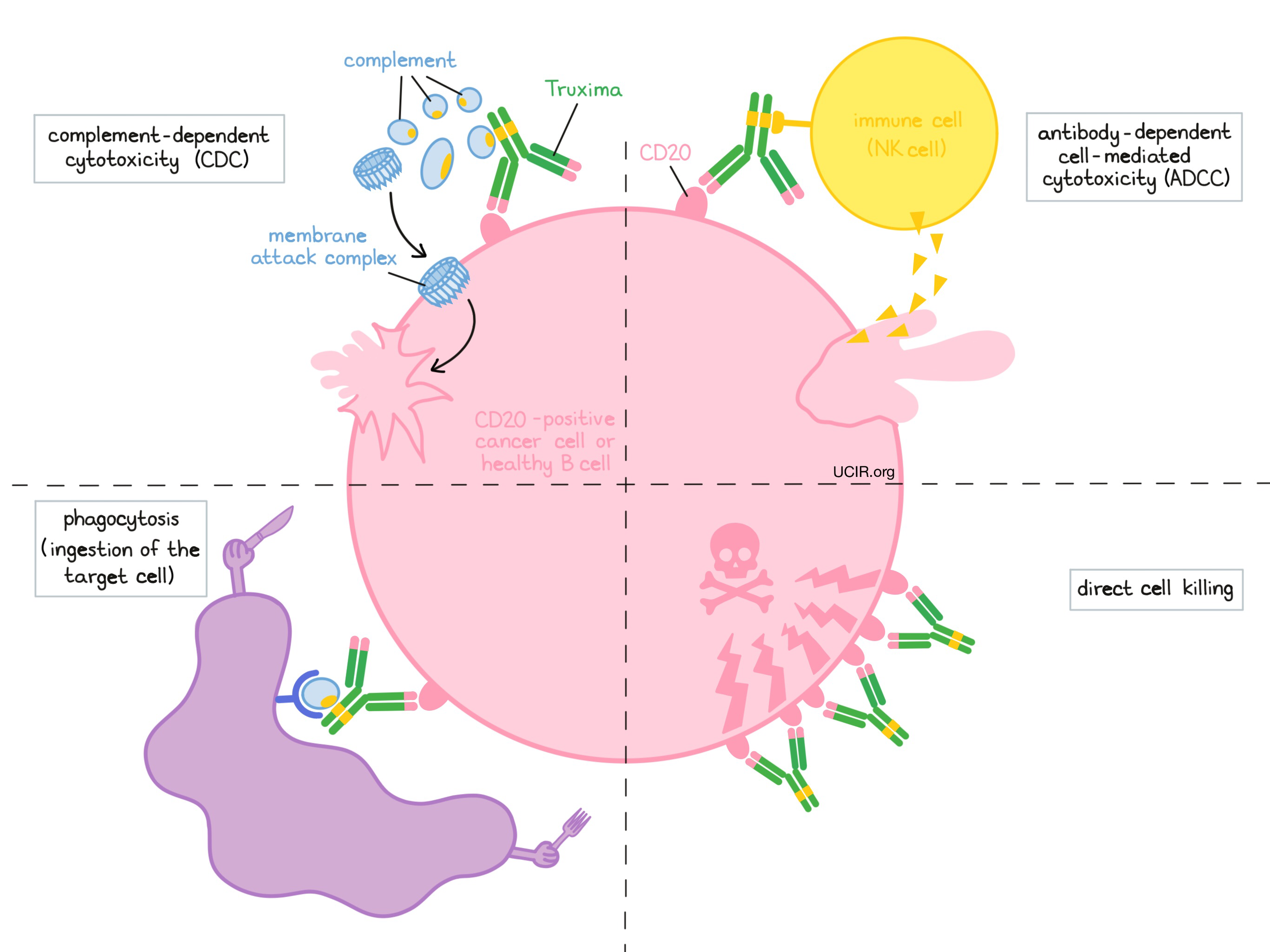
How is this drug given to the patient?
Truxima is administered through a tube in the vein (intravenous infusion, or I.V.) every week for 4-8 doses when given alone. The treatment schedules for Truxima as maintenance therapy or in combination with chemotherapy may be different. Patients will receive acetaminophen and an antihistamine prior to each infusion in order to reduce the risk of infusion-related side effects. Administration of Truxima does not require a hospital stay.
Before starting Truxima therapy, patients will need to get blood tests done to check if the patient is a carrier of the hepatitis B virus. Truxima can cause the virus to become active again, and the patients who test positive for the hepatitis B virus will need to be monitored more closely during treatment and for several months afterward. Blood tests are also used to obtain complete blood counts prior to each course of Truxima and on a regular basis during treatment, if needed. This is because reductions in the number of blood cells are particularly common in patients being treated with Truxima.
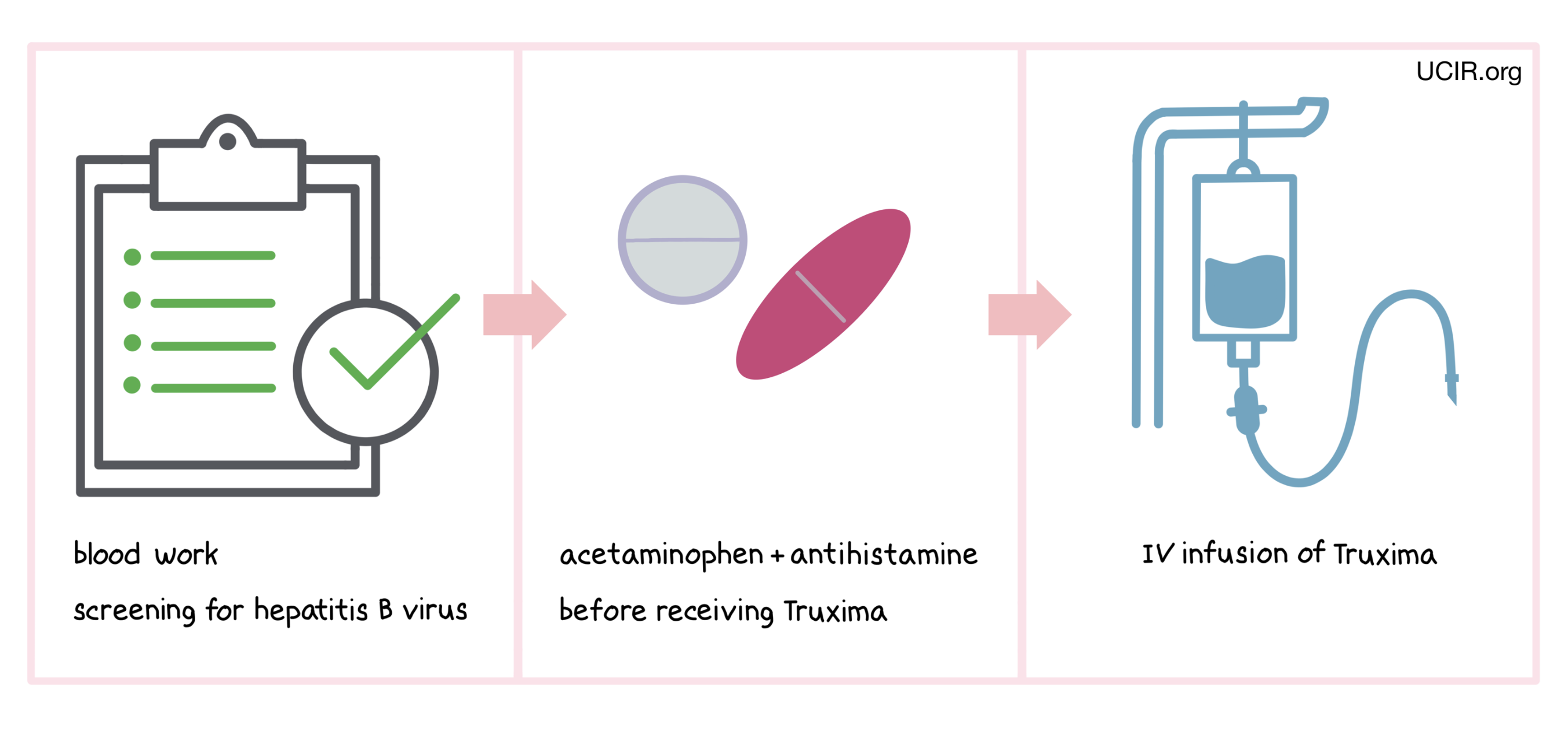
Patients with chronic lymphocytic leukemia will also receive treatment to prevent pneumonia and herpes virus infections during treatment with Truxima and for up to twelve months after the last Truxima dose. This is because Truxima weakens the immune system, increasing the risk of getting fungal infections that can cause pneumonia. It may also increase the patient’s risk of reactivation or infection by the herpes simplex virus.
The first infusion of Truxima is administered more slowly than subsequent infusions (over 4 to 6 hours) in order to monitor for infusion-related reactions. Such reactions are very common side effects of Truxima treatment and usually occur within 24 hours after the infusion. If symptoms of an infusion-related reaction occur at any point during the first infusion or any subsequent infusions, the infusion may be interrupted or slowed, depending on the severity of the reaction. It is important that patients discuss with their doctor if they notice any changes following a Truxima infusion, as infusion-related reactions are very serious and can be fatal.
What are the observed clinical results?
For:
Low-grade or follicular B-cell Non-Hodgkin lymphoma (previously treated)
Follicular B-cell Non-Hodgkin lymphoma (previously untreated)
Follicular B-cell Non-Hodgkin lymphoma (previously successfully treated with a rituximab product)
Low-grade B-cell Non-Hodgkin lymphoma (previously successfully treated with chemotherapy)
Diffuse large B-cell lymphoma (DLBCL; previously untreated)
Chronic lymphocytic leukemia (CLL; previously untreated)
Chronic lymphocytic leukemia (CLL; previously treated)
It is important to keep in mind that each patient’s actual outcome is individual and may be different from the results found in the clinical studies. In addition, immunotherapy can sometimes take several months to yield an observable treatment response.
Low-grade or follicular B-cell Non-Hodgkin lymphoma (relapsed or refractory)
In a clinical trial of 166 patients with low-grade or follicular B-cell Non-Hodgkin lymphoma who had been previously treated, but the cancer either did not respond to treatment or had since returned, patients were treated with rituximab (rituximab is the active ingredient in Truxima). At the beginning of the trial, 39 patients had disease-related symptoms. These symptoms went away in 25 (64%) of these patients. Overall, 48% of the patients responded to treatment, including 6% of participants whose tumor went away completely. The median time before a response was observed was 50 days, and responses lasted for a median of 11 months.
In another clinical trial of 60 patients with low-grade or follicular B-cell Non-Hodgkin lymphoma who had previously responded to a rituximab product (Rituxan, Truxima), but the cancer had since returned, patients were re-treated with rituximab. The median time between the response to the first treatment and the second treatment was 15 months. 38% of the patients responded to retreatment with rituximab, including 10% whose tumor went away completely. Responses lasted for a median of 15 months.
In the two trials above, 39 patients had bulky disease (a single tumor with more than 10 cm in diameter). 36% of these participants responded to retreatment with rituximab, including 3% whose tumors went away completely. Responses lasted for a median of 7 months.
Follicular B-cell Non-Hodgkin lymphoma (previously untreated)
In a clinical trial of 322 patients with previously untreated follicular B-cell Non-Hodgkin lymphoma, patients were treated with either rituximab (rituximab is the active ingredient in Truxima) plus cyclophosphamide, vincristine, and prednisone (CVP) chemotherapy, or with CVP chemotherapy alone. The disease did not get worse for a median of 2 years for patients treated with rituximab plus chemotherapy, compared to 1 year for patients who were treated with chemotherapy alone.
Follicular B-cell Non Hodgkin lymphoma (previously successfully treated with a rituximab product)
In a clinical trial of 1018 patients with follicular B-cell Non-Hodgkin lymphoma who had been previously successfully treated with a rituximab product (Rituxan or its equivalent Truxima) in combination with chemotherapy, patients were treated with either rituximab as maintenance therapy to prevent the cancer from getting worse or coming back, or were left untreated. At a median follow-up of 2 years, patients who had received rituximab as a maintenance therapy were nearly half (46%) as likely to die or to have their disease worsen or return, compared to patients who were left untreated.
Low-grade B-cell Non-Hodgkin lymphoma (previously treated with chemotherapy)
In a clinical trial of 322 patients with low-grade B-cell Non-Hodgkin lymphoma whose cancer did not get worse after initial treatment with cyclophosphamide, vincristine, and prednisone (CVP) chemotherapy, patients were treated with either rituximab (rituximab is the active ingredient in Truxima) as maintenance therapy to prevent the cancer from getting worse or coming back, or were left untreated. At a median follow-up of 28 months, patients who had received rituximab as a maintenance therapy were half (51%) as likely to die or to have their disease worsen or return, compared to patients who were left untreated.
Diffuse large B-cell lymphoma (DLBCL; previously untreated)
In a clinical trial of 632 patients with diffuse large B-cell lymphoma (DLBCL; including primary mediastinal B-cell lymphoma), patients were treated with either rituximab (rituximab is the active ingredient in Truxima) plus cyclophosphamide, doxorubicin, vincristine, and prednisone (CHOP) chemotherapy (R-CHOP), or with CHOP chemotherapy alone. In this trial, the majority (73%) of patients had stage 3 or 4 cancer. The disease did not get worse for a median of 3 years for patients treated with rituximab plus chemotherapy, compared to 2 years for patients who were treated with chemotherapy alone. At a median follow-up of 2 years, 74% of patients receiving rituximab plus chemotherapy were alive, compared to 63% of patients who were treated with chemotherapy alone.
In another clinical trial of 399 patients with diffuse large B-cell lymphoma (DLBCL), patients were treated with either rituximab (rituximab is the active ingredient in Truxima) plus CHOP chemotherapy, or with CHOP chemotherapy alone. In this trial, the majority (80%) of patients had stage 3 or 4 cancer. The disease did not get worse for a median of 3 years for patients treated with rituximab plus chemotherapy, compared to 1 year for patients treated with chemotherapy alone. At a median follow-up of 2 years, 69% of patients treated with rituximab plus chemotherapy were alive, compared to 58% of patients treated with chemotherapy alone. At a median follow-up of 5 years, 58% of patients treated with rituximab plus chemotherapy were alive, compared to 46% of patients treated with chemotherapy alone.
In a third clinical trial, 823 patients with diffuse large B-cell lymphoma (DLBCL) were treated with either rituximab (rituximab is the active ingredient in Truxima) plus an anthracycline-containing chemotherapy regimen, or with an anthracycline-containing chemotherapy regimen alone. In this study, 28% of the patients had stage 3 or 4 cancer. At a median follow-up of 2 years, 95% of patients treated with rituximab plus chemotherapy were alive, compared to 86% of patients treated with chemotherapy alone.
Chronic lymphocytic leukemia (CLL; previously untreated)
In a clinical trial of 817 patients with previously untreated chronic lymphocytic leukemia, patients were treated with either rituximab (rituximab is the active ingredient in Truxima) plus fludarabine and cyclophosphamide (FC) chemotherapy, or with FC chemotherapy alone. The disease did not get worse for a median of 40 months for patients treated with rituximab plus chemotherapy, compared to a median of 32 months for patients treated with chemotherapy alone. 86% of patients treated with rituximab plus chemotherapy had a response to treatment, compared to 73% of patients treated with chemotherapy alone.
Chronic lymphocytic leukemia (CLL; previously treated)
In a clinical trial of 522 patients with previously treated chronic lymphocytic leukemia, patients were treated with either rituximab (rituximab is the active ingredient in Truxima) plus fludarabine and cyclophosphamide (FC) chemotherapy, or with FC chemotherapy alone. The disease did not get worse for a median of 27 months for patients treated with rituximab plus chemotherapy, compared to 22 months for patients treated with chemotherapy alone. 54% of patients treated with rituximab plus chemotherapy had a response to treatment, compared to 45% of patients treated with chemotherapy alone.
What are the potential side effects?
Truxima targets the CD20 molecule, which, while present on cancerous B cells, is also present on normal B cells. As a result, Truxima can kill normal B cells, increasing the risk of serious infections. Other common side effects of Truxima include low white blood cell count and low red blood cell count.
Some side effects, such as reactions related to the infusion, severe skin and mouth reactions, severe infections, infections of the brain, hepatitis B virus reactivation, tumor lysis syndrome, heart problems, kidney problems, and stomach or bowel problems such as blockage or tears in the bowel, may be severe or life-threatening. Patients and caregivers receive careful instructions to monitor for signs and symptoms of these complications, and a healthcare provider should be immediately notified if symptoms occur. These conditions are managed by the health care provider.
Reactions to the Truxima infusion are common and usually occur within 24 hours after the infusion. Some of these reactions are serious and can be fatal. Symptoms include hives, rashes, swelling of lips, tongue, or face, sudden cough, shortness of breath, difficulty breathing, dizziness or feeling faint, heart racing or fluttering, and chest pain.
Severe skin and mouth reactions
Severe skin and mouth reactions can include blisters, peeling skin, rashes, and painful sores or ulcers on the skin, lips, or in the mouth.
Serious infections and hepatitis B virus reactivation Truxima can reduce the immune system’s ability to fight off bacterial, fungal, and viral infections, can increase a patient’s risk of getting an infection, and can cause the reactivation of prior virus infections. These infections can be serious, and may be fatal. Symptoms of infection include: fever; cold symptoms, such as a persistently runny nose or sore throat; flu symptoms, such as coughing, tiredness, and achiness; earache or headache; painful urination; cold sores; and cuts or scrapes that are red, warm, swollen, or painful. If the patient is a carrier of the hepatitis B virus, Truxima can cause the virus to become active. Hepatitis B can cause serious liver problems, including liver failure and death.
Progressive Multifocal Leukoencephalopathy (PML)
PML is a rare, serious brain infection that is caused by a virus. Individuals with weakened immune systems have an increased risk of infection. Symptoms of PML include confusion, dizziness or loss of balance, difficulty walking or talking, weakness on one side of the body, and vision problems.
Tumor Lysis Syndrome (TLS)
TLS is caused by the rapid breakdown of cancer cells. TLS can cause kidney failure. Symptoms of TLS include nausea, vomiting, diarrhea, and lack of energy.
Truxima can cause a number of heart-related problems, including life-threatening irregular heartbeats (arrhythmia), or a heart attack. Patients with a history of heart-related problems should be carefully monitored during and after Truxima infusion.
For a more complete list of possible side effects, see the full prescribing information.
Manufacturer
Teva Pharmaceuticals
Approval
FDA and EMA
Links to drug websites
Last updated: August 8, 2025
How is the drug name pronounced?
Rituximab: Ri-TUX-i-mab
Truxima: Truk-SEE-muh
Truxima (rituximab) is “biosimilar” to MabThera (rituximab). Truxima has been shown to be similar to MabThera in the way in which it works, how well it works, and how safe it is. Other approved drugs that are biosimilar to MabThera are Blitzima, Ritemvia, Riximyo, and Rixathon.
The US product name for MabThera is Rituxan.
What cancer(s) does this drug treat?
Truxima targets the CD20 molecule found on most B cells, and is only indicated for cancers that test positive for CD20.
B-cell Non-Hodgkin lymphoma (NHL)
Truxima is approved for:
- Adult patients with stage 3-4 follicular B-cell Non-Hodgkin lymphoma whose cancer did not respond to previous treatment with chemotherapy, or responded to two or more previous chemotherapy treatments but has since returned.
- Adult patients with previously untreated stage 3-4 follicular B-cell Non-Hodgkin lymphoma. In such cases, Truxima is given in combination with chemotherapy.
- Adult patients with follicular B-cell Non-Hodgkin lymphoma who have been successfully treated. In such cases, Truxima is given as maintenance therapy to prevent the cancer from getting worse or coming back.
- Adult patients with diffuse large B-cell lymphoma (DLBCL). In such cases, Truxima is given in combination with cyclophosphamide, doxorubicin, vincristine, and prednisone (CHOP) chemotherapy.
- Pediatric patients (6 months to 18 years old) with previously untreated advanced stage diffuse large B-cell lymphoma (DLBCL), Burkitt lymphoma (BL)/Burkitt leukemia (mature B-cell acute leukemia) (BAL) or Burkitt-like lymphoma (BLL) in combination with chemotherapy
Chronic lymphocytic leukemia (CLL)
Truxima is approved for:
- Adult patients with chronic lymphocytic leukemia who have previously been untreated or treated, but the cancer either did not respond to treatment or has since returned. In such cases, Truxima is given in combination with chemotherapy.
Limitations of Use
Age: The safety and efficacy of Truxima have not been established in patients under 18 years of age in any cancer indication other than previously untreated advanced stage diffuse large B-cell lymphoma (DLBCL), Burkitt lymphoma (BL)/Burkitt leukemia (mature B-cell acute leukemia) (BAL) or Burkitt-like lymphoma (BLL). Truxima should not be used in patients younger than 6 months of age.
Infections: Truxima can weaken the immune system and is not recommended for use in patients who currently have or recently had a severe infection. Patients will be screened for the hepatitis B virus prior to Truxima treatment. In patients who had hepatitis B in the past, or who are carriers of the hepatitis B virus, Truxima can cause the virus to become active again. These patients will need to be monitored closely during treatment and for several months after Truxima treatment. Patients with active hepatitis B disease should not be treated with Truxima.
Exclusions: Patients with a weakened or impaired immune system should not be treated with Truxima.
Vaccinations: Live virus vaccinations (e.g. chickenpox or measles, mumps, and rubella (MMR)) less than 4 weeks prior to or during Truxima treatment are not recommended. If possible, patients should be brought up to date with all necessary immunizations before starting Truxima therapy.
Pregnancy/breastfeeding: Truxima can cause harm to a fetus and is not recommended for use during pregnancy. Women who are able to become pregnant should use effective birth control while receiving Truxima, and for twelve months after the last dose of Truxima. Due to the potential for serious adverse reactions in a breastfed child, women are also advised not to breastfeed during treatment and for at least twelve months after the last dose of Truxima.
What type of immunotherapy is this?
How does this drug work?
Target:
Truxima is an antibody that was made in the laboratory. Truxima and other antibody molecules have an overall “Y” shape. The two tips of the upper arms of the “Y” shape are the parts of the antibody that can very precisely bind to its target. Truxima binds to a molecule called CD20 on the surface of a cancerous B cell. CD20 is commonly found on the surface of cancer cells in patients with Non-Hodgkin lymphoma and chronic lymphocytic leukemia (CLL). CD20 can also be found on the surface of all normal human B cells, which means that in addition to attacking cancer cells, Truxima can also attack healthy B cells.
The stem of Truxima’s “Y” shape has binding sites for immune cells or other parts of the immune system.
At least four different mechanisms are thought to be responsible for the elimination of CD20-positive B cells by Truxima. Truxima is helped by the immune system to kill cancer cells and may also work alone.
Complement-dependent cytotoxicity (CDC)
When bound to CD20 on the surface of cancerous or normal B cells, the “stem” of Truxima can attract and bind molecules of the immune system that freely flow in the blood or tissues, and are called “complement”. Activation of the complement system causes the formation of the “membrane attack complex”, which can puncture and destroy the cell that Truxima is bound to. This is understood to be the main way through which Truxima kills cells.
Antibody-dependent cell-mediated cytotoxicity (ADCC)
When bound to CD20 on the surface of cancerous or normal B cells, the “stem” of Truxima can also attract and bind immune cells (like NK cells). This allows Truxima to act as a bridge between the target cell and the immune cell. The immune cell then releases molecules that can kill the cell Truxima is bound to.
Phagocytosis
When Truxima is bound to cancerous or normal B cells, it can also attract immune cells, called phagocytes, that have the ability to ingest (“eat”) cells that have been coated with Truxima or parts of the complement system. Phagocytosis is not a major way through which Truxima kills cells.
Direct cell killing
By binding to CD20 molecules on the surface of cancerous or normal B cells and bringing the CD20 molecules close together in “clusters”, Truxima can directly cause the cells to die, although this is not a major way through which Truxima kills cells.
The combined effect of these mechanisms results in the elimination of cancerous and normal B cells from the body. A new population of healthy B cells can then develop from blood-forming ‘stem’ cells that reside in the bone marrow.
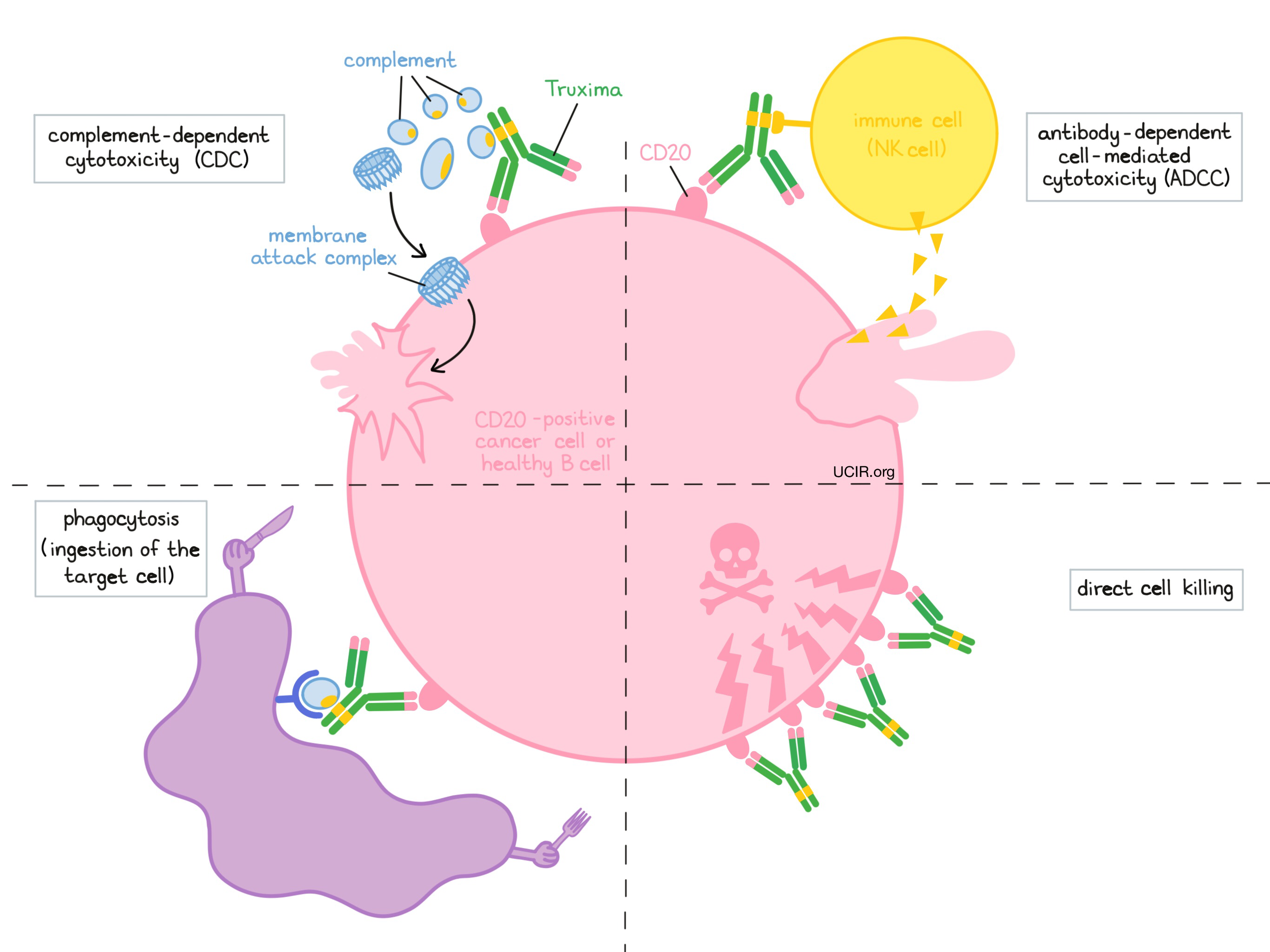
How is this drug given to the patient?
Truxima is administered through a tube in the vein (intravenous infusion, or i.v.) every week for 4-8 doses when given alone. The treatment schedules for Truxima as maintenance therapy or in combination with chemotherapy may be different. Patients will receive paracetamol and an antihistamine prior to each infusion in order to reduce the risk of infusion-related side effects. In some cases patients may also receive glucocorticoids before Truxima treatment. Administration of Truxima does not require a hospital stay.
Before starting Truxima therapy, patients will need to get blood tests done to check if the patient is a carrier of the hepatitis B virus. Truxima can cause the virus to become active again, and the patients who test positive for the hepatitis B virus will need to be monitored more closely during treatment and for several months afterward. Blood tests are also used to obtain complete blood counts prior to each course of Truxima and on a regular basis during treatment, if needed. This is because reductions in the number of blood cells are particularly common in patients being treated with Truxima.
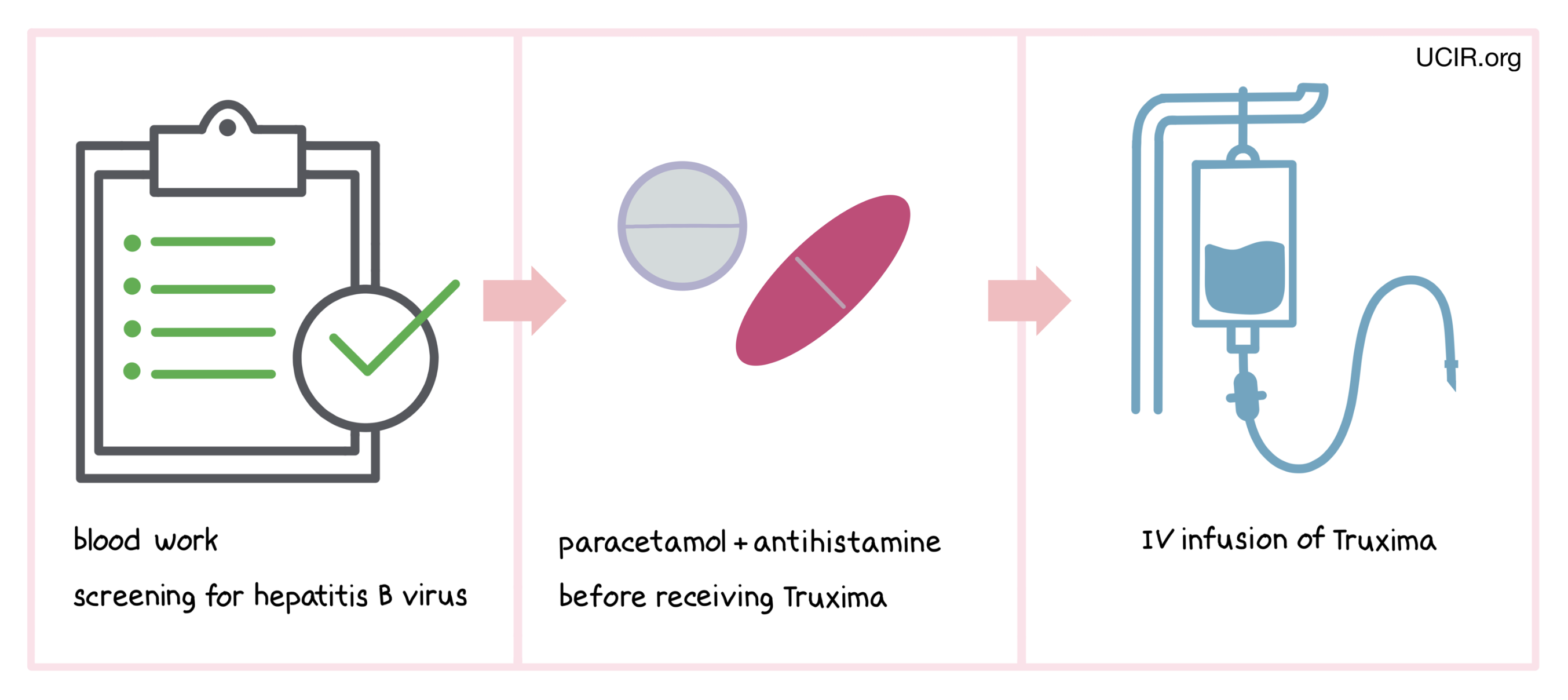
Patients with chronic lymphocytic leukemia (CLL) will also receive treatment (adequate hydration and uricostatics) before infusion with Truxima to reduce the risk of tumor lysis syndrome (inflammation due to rapid breakdown of the tumor) and decrease the risk and severity of reactions to the infusion.
The first infusion of Truxima is administered more slowly than subsequent infusions (over 4 to 6 hours) in order to monitor for infusion-related reactions. Such reactions are very common side effects of Truxima treatment and usually occur within 24 hours after the infusion. If symptoms of an infusion-related reaction occur at any point during the first infusion or any subsequent infusions, the infusion may be interrupted or slowed, depending on the severity of the reaction. It is important that patients discuss with their doctor if they notice any changes following a Truxima infusion, as infusion-related reactions are very serious and can be fatal.
What are the observed clinical results?
For:
Follicular B-cell Non-Hodgkin lymphoma (previously treated)
Follicular B-cell Non-Hodgkin lymphoma (previously untreated)
Follicular B-cell Non-Hodgkin lymphoma (previously successfully treated with chemotherapy and a rituximab product)
Diffuse large B-cell lymphoma (DLBCL; previously untreated)
Mature B-cell Non-Hodgkin lymphoma in children
Chronic lymphocytic leukemia (CLL)
It is important to keep in mind that each patient’s actual outcome is individual and may be different from the results found in the clinical studies. In addition, immunotherapy can sometimes take several months to yield an observable treatment response.
Follicular B-cell Non-Hodgkin lymphoma (previously treated)
In a clinical trial of 166 patients with low-grade or follicular B-cell Non-Hodgkin lymphoma who had been previously treated, but the cancer either did not respond to treatment or had since returned, patients were treated with rituximab (rituximab is the active ingredient in Truxima). Overall, 48% of the patients responded to treatment (tumors shrank or went away completely), including 6% of participants whose tumor went away completely. Patients did not experience a worsening or return of their disease for a median of 13 months.
In another clinical trial of 58 patients with low-grade or follicular B-cell Non-Hodgkin lymphoma who had previously responded to a rituximab product (MabThera or one of its equivalents, e.g. Truxima), but the cancer had since returned, patients were re-treated with rituximab. 38% of the patients responded to retreatment with rituximab, including 10% whose tumor went away completely. Patients did not experience a worsening or return of their disease for a median of 18 months, compared to 12 months for the prior treatment with a rituximab product.
In the two trials above, 39 patients had bulky disease (a single tumor with more than 10 cm in diameter). 36% of these participants responded to retreatment with rituximab, including 3% whose tumors went away completely. Patients did not experience a worsening or return of their disease for a median of 10 months.
Follicular B-cell Non-Hodgkin lymphoma (previously untreated)
In a clinical trial of 321 patients with previously untreated follicular B-cell Non-Hodgkin lymphoma, patients were treated with either rituximab (rituximab is the active ingredient in Truxima) plus cyclophosphamide, vincristine, and prednisone (CVP) chemotherapy, or with CVP chemotherapy alone. At a median follow-up of 53 months:
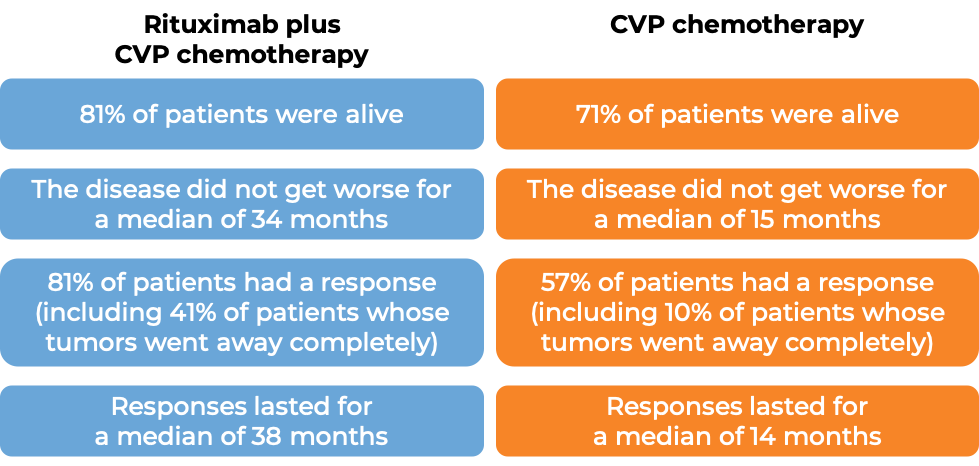
Results from three other clinical trials using a rituximab product (MabThera or one of its equivalents, e.g. Truxima) in combination with chemotherapy other than CVP, including:
- cyclophosphamide, doxorubicin, vincristine, and prednisone (CHOP) chemotherapy, OR
- mitoxantrone, chlorambucil, and prednisone (MCP) chemotherapy, OR
- cyclophosphamide, doxorubicin, teniposide, and prednisone (CHVP) chemotherapy plus interferon-α
have demonstrated similar clinical improvements for patients compared to the corresponding chemotherapy treatment alone.
428 patients with previously untreated follicular B-cell Non-Hodgkin lymphoma were treated with either rituximab plus cyclophosphamide, doxorubicin, vincristine, and prednisone (CHOP) chemotherapy, or with CHOP chemotherapy alone. At a median follow-up of 18 months:

201 patients with previously untreated follicular B-cell Non-Hodgkin lymphoma were treated with either rituximab (rituximab is the active ingredient in Truxima) plus mitoxantrone, chlorambucil, and prednisone (MCP) chemotherapy, or with MCP chemotherapy alone. At a median follow-up of 4 years:

358 patients with previously untreated follicular B-cell Non-Hodgkin lymphoma were treated with either rituximab (rituximab is the active ingredient in Truxima) plus cyclophosphamide, doxorubicin, teniposide, and prednisone (CHVP) chemotherapy with interferon-α, or with CHVP-interferon-α therapy alone. At a median follow-up of 42 months:

Follicular B-cell Non Hodgkin lymphoma (previously successfully treated with chemotherapy and a rituximab product)
In a clinical trial of 1193 patients with previously untreated advanced follicular B-cell Non-Hodgkin lymphoma, patients were treated with a rituximab product (MabThera or one of its equivalents, e.g. Truxima) plus chemotherapy according to the investigators’ choice, including:
- cyclophosphamide, doxorubicin, vincristine, and prednisone (CHOP) chemotherapy, OR
- cyclophosphamide, vincristine, and prednisone (CVP) chemotherapy, OR
- fludarabine, cyclophosphamide, and mitoxantrone (FCM) chemotherapy
A total of 1078 patients responded to this first therapy, of which 1018 were either treated with rituximab as maintenance therapy to prevent the cancer from getting worse or coming back, or were left untreated. At a median follow-up of 25 months:

The long-term benefit of rituximab maintenance therapy was evaluated at a median follow-up of 9 years for all patients on the trial:

In another clinical trial of 465 patients with previously treated follicular B-cell Non-Hodgkin lymphoma, patients were treated with either rituximab (rituximab is the active ingredient in Truxima) plus cyclophosphamide, doxorubicin, vincristine, and prednisolone (CHOP) chemotherapy or CHOP chemotherapy alone. A total of 334 patients saw their tumors shrink or disappear in response to this treatment, and those 334 patients were either treated with rituximab as maintenance therapy to prevent the cancer from getting worse or coming back, or were left untreated. At a median follow-up of 28 months for all patients on the trial after starting maintenance therapy or observation:

The benefit of rituximab maintenance treatment compared to observation was confirmed in all subgroups analysed, regardless of initial treatment (rituximab plus CHOP chemotherapy or CHOP chemotherapy alone) or the quality of response to initial treatment (tumor shrinkage or complete tumor disappearance). However, patients who were treated with a rituximab product plus CHOP chemotherapy before starting rituximab maintenance therapy showed better disease control during the maintenance phase than patients treated with CHOP chemotherapy alone.


Diffuse large B-cell lymphoma (DLBCL; previously untreated)
In a clinical trial of 399 patients aged 60 to 80 with previously untreated diffuse large B-cell lymphoma (DLBCL), patients were treated with either rituximab (rituximab is the active ingredient in Truxima) plus cyclophosphamide, doxorubicin, vincristine, and prednisone (CHOP) chemotherapy, or with CHOP chemotherapy alone. At a median follow-up of 31 months for all patients on the trial:
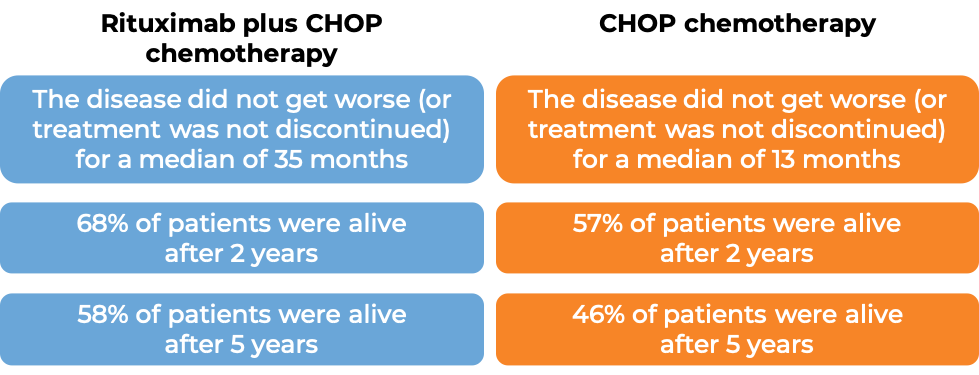
Mature B-cell Non-Hodgkin lymphoma in children
In a clinical trial, 328 pediatric patients with previously untreated advanced stage diffuse large B-cell lymphoma (DLBCL), Burkitt lymphoma (BL)/Burkitt leukemia (mature B-cell acute leukemia) (BAL) or Burkitt-like lymphoma (BLL), were treated with either
- Rituximab (rituximab is the active ingredient in Truxima) plus Lymphome Malin B (LMB) chemotherapy, OR
- Lymphome Malin B (LMB) chemotherapy alone (LMB chemotherapy: corticosteroids, vincristine, cyclophosphamide, high-dose methotrexate, cytarabine, doxorubicin, etoposide, and triple drug [methotrexate/cytarabine/corticosteroid] therapy, which is injected into the fluid-filled space between the thin layers of tissue that cover the spinal cord)
At a median follow-up of 3 years:
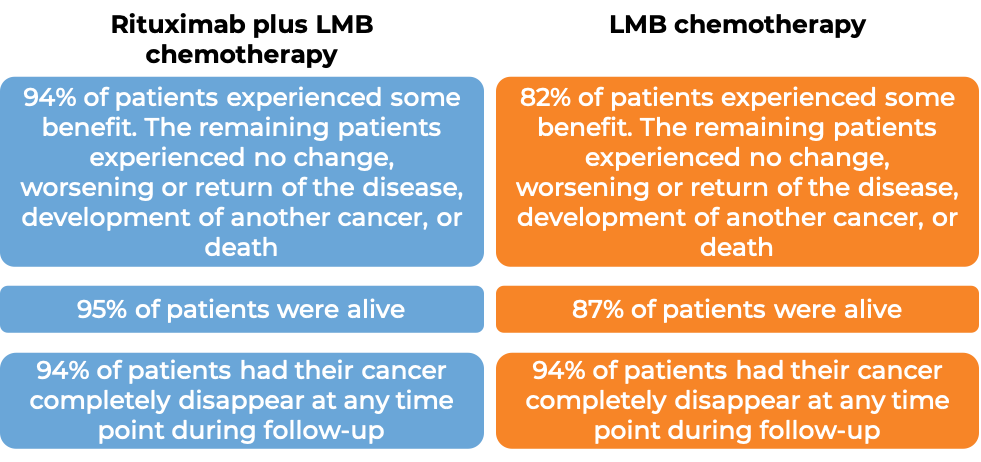
Chronic lymphocytic leukemia (CLL)
Previously untreated CLL
In a clinical trial of 817 patients with previously untreated chronic lymphocytic leukemia, patients were treated with either rituximab (rituximab is the active ingredient in Truxima) plus fludarabine and cyclophosphamide (FC) chemotherapy, or with FC chemotherapy alone. At a median follow-up of 4 years for all patients on the trial:
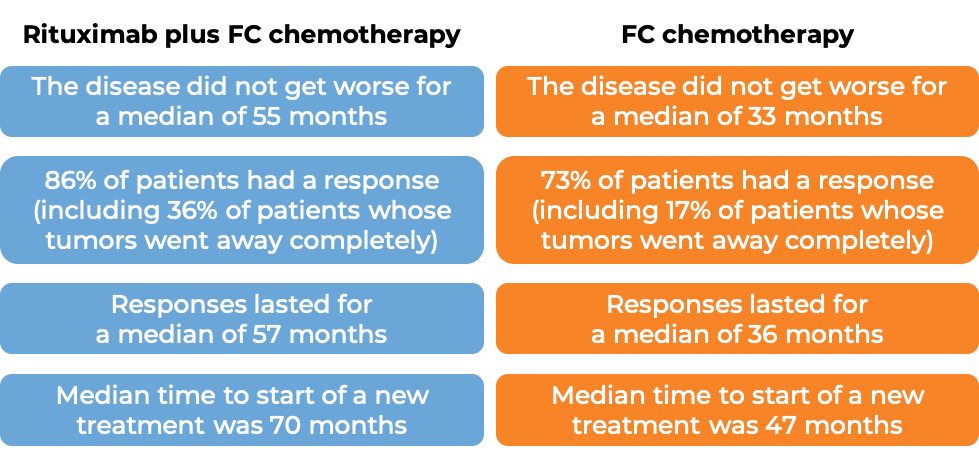
Previously treated CLL
In a clinical trial of 522 patients with previously treated chronic lymphocytic leukemia, patients were treated with either rituximab (rituximab is the active ingredient in Truxima) plus fludarabine and cyclophosphamide (FC) chemotherapy, or with FC chemotherapy alone. At a median follow-up of 2 years for all patients on the trial:
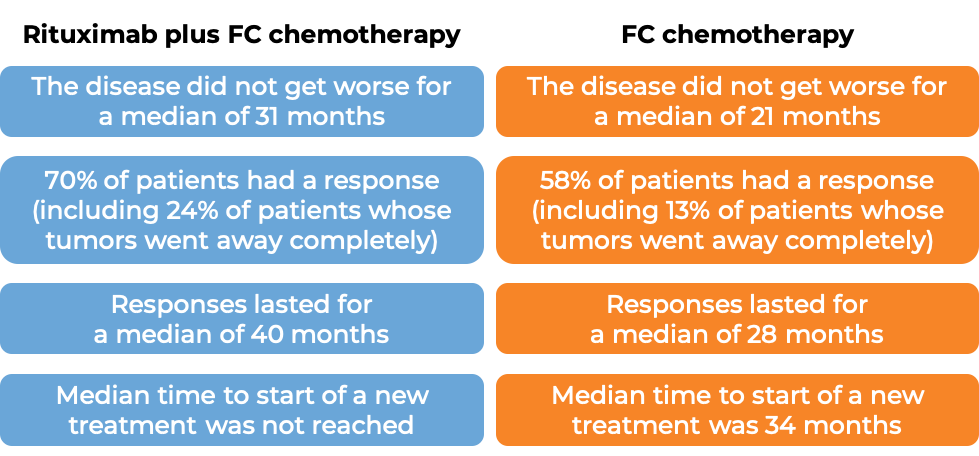
Results from other clinical studies using rituximab (rituximab is the active ingredient in Truxima) in combination with chemotherapy other than FC, including:
- cyclophosphamide, doxorubicin, vincristine, and prednisone (CHOP) chemotherapy, OR
- fludarabine, cyclophosphamide, and mitoxantrone (FCM) chemotherapy, OR
- paclitaxel and carboplatin (PC) chemotherapy, OR
- paclitaxel, cyclophosphamide, and mitoxantrone (PCM) chemotherapy, OR
- bendamustine and cladribine chemotherapy
have shown clinical benefit for patients with previously treated or untreated CLL compared to the corresponding chemotherapy treatment alone.
Data from approximately 180 patients who had been previously treated with a rituximab product and were then again treated with rituximab have shown clinical benefit.
What are the potential side effects?
Truxima targets the CD20 molecule, which, while present on cancerous B cells, is also present on normal B cells. As a result, Truxima can kill normal B cells, increasing the risk of serious infections. Other common side effects of Truxima include low white blood cell count and low red blood cell count.
Some side effects, such as reactions related to the infusion, severe skin and mouth reactions, severe infections, infections of the brain, hepatitis B virus reactivation, tumor lysis syndrome, heart problems, kidney problems, and stomach or bowel problems such as blockage or tears in the bowel, may be severe or life-threatening. Patients and caregivers receive careful instructions to monitor for signs and symptoms of these complications, and a healthcare provider should be immediately notified if symptoms occur. These conditions are managed by the health care provider.
Infusion-related reactions Reactions to the Truxima infusion are common and usually occur within 24 hours after the infusion. Some of these reactions are serious and can be fatal. Symptoms include hives, rashes, swelling of lips, tongue, or face, sudden cough, shortness of breath, difficulty breathing, dizziness or feeling faint, heart racing or fluttering, and chest pain. Reactions to Truxima infusion may be caused by a combination of a widespread release of molecules called cytokines or other inflammatory substances, tumor lysis syndrome (inflammation due to rapid breakdown of the tumor), and severe allergic or hypersensitivity reactions.
Severe skin and mouth reactions Severe skin and mouth reactions can include blisters, peeling skin, rashes, and painful sores or ulcers on the skin, lips, or in the mouth.
Serious infections and hepatitis B virus reactivation Truxima can reduce the immune system’s ability to fight off bacterial, fungal, and viral infections, can increase a patient’s risk of getting an infection, and can cause the reactivation of prior virus infections. These infections can be serious, and may be fatal. Symptoms of infection include: fever; cold symptoms, such as a persistently runny nose or sore throat; flu symptoms, such as coughing, tiredness, and achiness; earache or headache; painful urination; cold sores; and cuts or scrapes that are red, warm, swollen, or painful. If the patient is a carrier of the hepatitis B virus, Truxima can cause the virus to become active. Hepatitis B can cause serious liver problems, including liver failure and death.
Progressive Multifocal Leukoencephalopathy (PML) and enteroviral meningoencephalitis PML and enteroviral meningoencephalitis are very rare, serious brain infections that are caused by a virus. Individuals with weakened immune systems have an increased risk of infection. Symptoms of PML include confusion, memory loss, dizziness or loss of balance, difficulty walking or talking, weakness on one side of the body, and vision problems, and may be fatal. Symptoms of enteroviral meningoencephalitis include fever, headache, stiff neck, incoordination, personality changes, hallucinations, altered consciousness, seizures, and coma, and may be fatal.
Tumor Lysis Syndrome (TLS) TLS is caused by the rapid breakdown of cancer cells. TLS can cause kidney failure. Symptoms of TLS include nausea, vomiting, diarrhea, and lack of energy.
Heart-related problems Truxima can cause a number of heart-related problems, including life-threatening irregular heartbeats (arrhythmia), or a heart attack. Patients with a history of heart-related problems should be carefully monitored during and after Truxima infusion.
For a more complete list of possible side effects, see the full prescribing information.
Manufacturer
Celltrion
Approval
FDA and EMA
Links to drug websites
Last updated on August 7, 2025



















